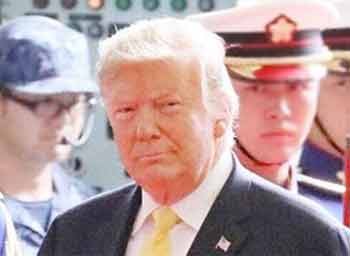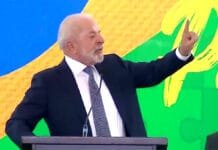INVC NEWS Riyadh- The unexpected appearance of U.S. President Donald Trump alongside Saudi Crown Prince Mohammed bin Salman and Syria’s interim President Ahmed Al Shara in Riyadh has sparked intense international debate. This landmark meeting is being seen not merely as a symbolic gesture, but a pivotal moment that could reshape the geopolitical dynamics of West Asia. With the region already in flux due to shifting alliances and military withdrawals, this development marks a potential realignment of power in a post-Assad Syria, and the global community is watching with bated breath.
From Most Wanted to Presidential Recognition: The Rise of Ahmed Al Shara
Ahmed Al Shara, formerly known as Mohammad Al Jolani or Golani, was once one of the most wanted terrorists on U.S. and UN watchlists. With a deep-rooted history in organizations like Al Qaeda and ISIS, Al Shara was notorious for his involvement in fundraising, arms smuggling, and direct coordination with terror leaders like Ayman Al Zawahiri and Abu Bakr Al Baghdadi. As the founder of Al Nusra Front, later rebranded to Jabhat Fatah al-Sham and eventually to Hayat Tahrir al-Sham (HTS), his influence in Syria grew significantly through the 2010s.
Despite his past, Al Shara led the anti-Assad rebellion beginning in 2011, gaining traction amid widespread dissent and the collapse of governance in many Syrian regions. By the time Bashar al-Assad fled Syria in December 2024, Al Shara had consolidated power, positioning HTS as the de facto authority in northwestern Syria. In the absence of Russian support—diverted by the ongoing Ukraine conflict—Al Shara declared himself interim president, filling the vacuum left by Assad’s fall.
Saudi Arabia’s Strategic Maneuvering
The role of Saudi Arabia in orchestrating this high-stakes diplomatic encounter cannot be understated. Crown Prince Mohammed bin Salman (MBS) has long pursued a strategy to counter Iranian influence in Syria, especially after the downfall of the Iran-backed Assad regime. By bridging ties between the United States and the controversial new Syrian leadership, MBS aims to anchor Riyadh’s influence in the heart of the Levant.
Saudi Arabia’s initiative reflects a bold regional recalibration. With Iran’s leverage diminished and Russia distracted, Riyadh is seizing the moment to emerge as a kingmaker in post-conflict Syria. MBS’s role in arranging this meeting signals a readiness to normalize relations with Al Shara’s administration under a new framework—one that marginalizes Iran while aligning more closely with American strategic interests.
America’s Return to Syrian Affairs
With Assad gone and Russia sidelined, Washington has moved swiftly to re-engage with Syria under new terms. Trump’s presence in Riyadh, alongside leaders once considered irreconcilable enemies, demonstrates a dramatic policy shift. The U.S. has lifted decades-old sanctions on Syria, first imposed in 1979, signaling a potential path toward recognition of Al Shara’s government—albeit cautiously.
The implications are enormous. By stepping into the Syrian arena again, the United States positions itself as a stabilizing force in the region. This not only thwarts any residual Iranian influence but also opens the door for American corporate and military interests to participate in Syria’s reconstruction. The geopolitical chessboard is being reset, and Washington appears ready to reclaim its stake in West Asia.
The Israeli Dilemma and Stark Warnings
While the U.S. and its allies celebrate this diplomatic breakthrough, Israel remains deeply concerned. The Israeli government has issued stern warnings about legitimizing the Al Shara-led regime, emphasizing the terrorist roots of HTS. Tel Aviv fears that any normalization or support might empower militant elements within Syria and create a new security threat on its northern border.
Israel’s skepticism is grounded in reality. Despite HTS’s recent political makeover, many analysts believe its core ideology remains unchanged. Jerusalem views the American-Saudi initiative as premature and risky, potentially undermining decades of counterterrorism efforts in the region. As tensions escalate, Israel is likely to adopt a more defensive posture, possibly increasing military surveillance and strike capabilities along the Syrian frontier.
Regional Power Shifts: Turkey, Arab League, and the New Order
Beyond the trilateral axis of the U.S., Saudi Arabia, and Syria, the meeting in Riyadh has ignited support across the Arab world. Nations including Turkey, Egypt, Jordan, and others within the Arab League have cautiously welcomed the emergence of a new Syrian government, especially one distanced from Iranian and Russian entanglements.
Turkey, in particular, views Al Shara as a pragmatic alternative to Assad. Ankara’s long-standing concerns over Kurdish autonomy and cross-border militancy make cooperation with Damascus a potentially stabilizing force in northern Syria. Similarly, Gulf nations are eager to reintegrate Syria into the regional economic and diplomatic network, provided the new leadership commits to moderation and reforms.
The Arab League’s next summit is expected to place Syria’s status on the agenda, with a potential pathway toward restoring Syria’s full membership. If this happens, the balance of power in West Asia will tilt significantly in favor of Sunni Arab coalitions aligned with U.S. interests.
Strategic Calculations: The Real Winners and Losers
This unprecedented summit reshuffles traditional alliances and introduces new power centers into the regional matrix. The winners in this scenario appear to be:
The United States, for reasserting influence in Syria without deploying ground troops.
Saudi Arabia, for brokering a deal that aligns with its anti-Iranian goals.
Ahmed Al Shara, for transitioning from pariah to political player.
On the other hand, the losers include:
Iran, now largely ousted from Syrian affairs.
Russia, unable to maintain its Syrian foothold amid distractions in Ukraine.
Israel, caught between security concerns and its reliance on U.S. diplomacy.
The Future of Syrian Governance
The road ahead for Syria remains uncertain. While Al Shara’s ascent to power marks a new chapter, his past affiliations with extremist groups continue to cast a long shadow. The international community will demand transparency, institutional reforms, and security assurances before full recognition is granted. Nevertheless, with backing from the U.S. and Gulf states, Al Shara has an opportunity to transform his legacy and guide Syria through a fragile, yet promising, transition.
A New Era in West Asian Politics
The meeting between President Donald Trump, Ahmed Al Shara, and Mohammed bin Salman in Riyadh represents far more than a photo-op—it is a defining moment in the history of West Asian diplomacy. It marks the emergence of a new geopolitical axis, the decline of legacy regimes, and the potential for a realignment of global interests in the region. As old alliances fracture and new coalitions form, the world watches as Syria, long a battlefield of proxies, might finally take its first steps toward stability and reintegration—under a leader the world once hunted.















